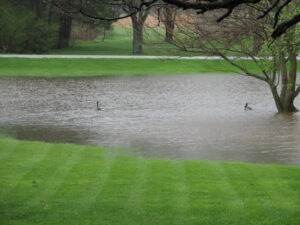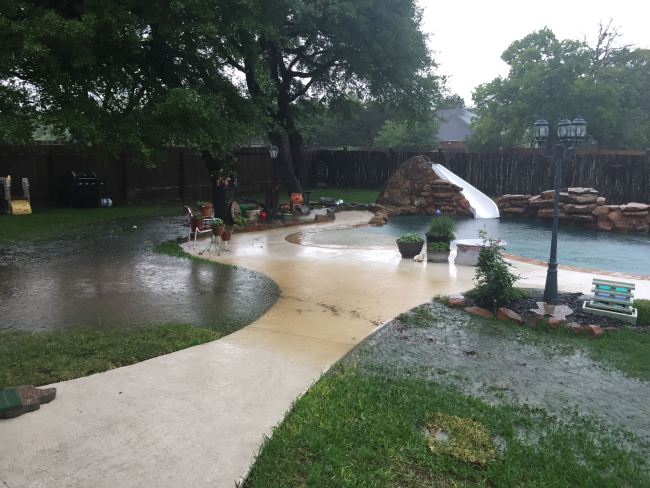April Showers bring May Flowers? It looks like the first few days of May are bringing more rain showers than actual flowers. Rain totals for spring of 2019 in the Carmel, Indiana area are running more than 2 inches above average. We are seeing a lot of agriculture flooding in Hamilton County, and low-lying neighborhoods. The fields and properties in Central Indiana are flooded. For many homeowners, soggy lawns could turn into big problems.
Owner Royce Simpkins says “Standing water could have severe impact on our lawns. With all the Rain we are currently experiencing, it causes delays with our crews being able to get onto the lawns to treat, mow and take care of landscape. Please be patient and understand that we will be there as soon as possible.”
Lawn Problems Caused by Excessive Rain
Surface damage – Walking and moving objects like trash cans across a saturated lawn will not only compact soils, but it can leave permanent marks or tracks in your yard.
Drown grass roots – Grass needs oxygen to grow, and excessive water will fill the air gaps in the soil, effectively drowning the plants.
Disease caused by fungus – Too much water can cause grass roots to rot and can lead to disease which starts off as yellow patches in your yard; once fungus sets in, you will need to treat with fungicide treatments or reseed the dead patches in the fall.
Shallow root growth – Grass roots that don’t have to go far below the surface to find water can’t withstand drier conditions, leading to dead brown patches.
Prone to disease and insects – When your lawn has a shallow root system, the grass becomes stressed, making it more susceptible to damage from insects and disease.
More weeds – Excessive rainfall causes a lot of hard-to-kill weeds to grow. Little can be done till the area is dry enough to treat.
Loss of nutrients – If your lawn gets too much water, vital nutrients are washed away before they can be absorbed through the root system.
Excessive fertilizer needs – Because your grass isn’t getting the nutrients it needs, you’ll have to use additional fertilizer to try and compensate.
Steps to Help Lawns with Excessive Rain
Of course, you can’t control the rain, but you can take steps to help your lawn get through periods of heavy rain.
Make sure your yard has proper drainage
After a rain storm, check your yard for puddles or standing water. If there are low spots in your yard, bringing in some fill dirt and reseeding the area can help. Also, make sure your rain gutters are clean and that the downspouts have extenders on them to direct water away from your home’s foundation. You can even install extenders that can be buried to form a french drain system that disperses the water underground instead of on your lawn’s surface.
Know when to treat your lawn
The soil needs to dry to develop deep root growth and thick grass coverage, which means your lawn needs several days of sunshine and warmer temperatures. You’ll need to adjust your fertilizer treatments this season to avoid damage to your lawn and compaction.
If you have a sprinkler system, consider installing a rain sensor
Central Indiana lawns are saturated, adding a rain sensor to your irrigation system controls will prevent the sprinklers from running when it’s raining. In addition to keeping your lawn healthy, you’ll save money and conserve water.
Need help dealing with the effects of too much rain on your lawn? Call the professionals at GreenLawn by Design today at 317-804-8088.


